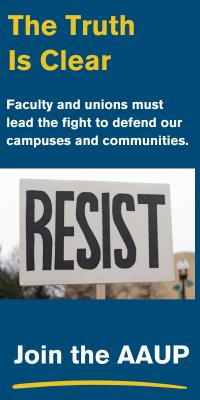- About
- Programs
- Issues
- Academic Freedom
- Political Attacks on Higher Education
- Resources on Collective Bargaining
- Shared Governance
- Campus Protests
- Faculty Compensation
- Racial Justice
- Diversity in Higher Ed
- Financial Crisis
- Privatization and OPMs
- Contingent Faculty Positions
- Tenure
- Workplace Issues
- Gender and Sexuality in Higher Ed
- Targeted Harassment
- Intellectual Property & Copyright
- Civility
- The Family and Medical Leave Act
- Pregnancy in the Academy
- Publications
- Data
- News
- Membership
- Chapters
From the General Secretary: The Freedom to Engage
The pitch made by community colleges to prospective students is not unlike that made by liberal arts colleges. Both emphasize their small classes and the personal attention students receive from professors who know their names and are available to engage and mentor them.
It is ironic, then, that over the past few decades community colleges have systematically disinvested from their faculties, creating structures of employment that make engaging students very difficult. The number and proportion of community college faculty hired in non-tenure-track positions has been growing at precisely the time when increasing numbers of community college students require fuller engagement to enhance their learning outcomes. Contingent faculty members are afforded substantially fewer due process protections and less academic freedom than those on the tenure track, which undermines their ability to provide an education that challenges students, not to mention one that builds faculty-student relationships.
The working conditions of the vast majority of faculty in community colleges (and, indeed, of more than two-thirds of faculty in all colleges and universities) undercut their academic freedom and their ability to fulfill their professional and social responsibilities to their students, their institutions, and society. The education that students receive therefore suffers. The problem is not the quality of the individual professors in contingent positions but the collective working conditions of the profession in these settings.
In a corporatized higher education environment, most community college faculty members are just one unhappy student or administrator away from nonrenewal or dismissal. This context threatens professors’ freedom and responsibility to challenge students intellectually with demanding academic practices and tough standards and grading. The implicit and sometimes explicit pressure is for instructors to keep the student “customers” satisfied.
Similarly, contingent employment contracts—along with the increasing characterization of education, particularly in community colleges, as merely the delivery of information— inhibit professors from challenging students’ beliefs in a process that fosters critical thinking. Fears that students will complain if certain issues are addressed from differing vantage points, especially in an environment in which one phrase or word can be seized upon and “go viral” online, chill the faculty’s ability to guide students through difficult conversations, not simply about social issues but also about politicized issues in science and controversial matters of professional practice (for example, in health sciences).
Further, the corporatized environment of at-whim employment, subject to the caprice of administrators, compromises the freedom and responsibility of professors to address significant social and technical problems and to critique the prevailing situations and institutions in which students live and work (this is clearly the case in workforce education, the growth curriculum in community colleges, but it is true in professional, technical, and vocational fields as well). There are also disincentives to reform, particularly when the curriculum is set up to track students into specific employment settings, even specific businesses.
Finally, the current structure of employment separates the vast majority of the academic workforce from the governance of the college. A fundamental dimension of faculty members’ academic freedom and responsibility lies in their being key players, as a body, in various arenas of shared governance, particularly in regard to the curriculum. That professors play the primary role in shaping the curriculum is essential to quality not only in the classroom but also in the college as a whole.
My comments about academic freedom and responsibility, and the current structure of employment in academe, by no means apply only to community colleges. However, these structures are particularly threatening to academic freedom and professors’ social responsibility to the public in an organizational setting where so much teaching is done by part-time, short-term faculty and so little governance goes on in structures such as faculty senates. If colleges are to engage students meaningfully and prepare them for success, they must engage and support faculty meaningfully with working conditions that enhance educators’ ability to exercise their academic freedom and fulfill their responsibilities to students, the college, and society.



